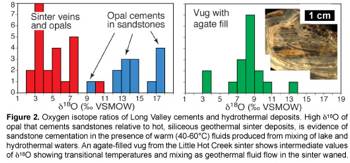AmericanChemicalSociety.com
Reports: UNI8 50152-UNI8: Sandstone Silicification in a Caldera Lake: Implications for Cementation at High Geothermal Gradients
Jade Star Lackey, PhD, Pomona College
The primary objectives for year 1
included: (1) to sample and describe volcaniclastic sandstones in the field
area; (2) to characterize cements; (3); analysis of oxygen isotope ratios in
cements as a measure of homogeneity of heterogeneity of fluid composition and
temperatures of cement precipitation. As a whole these objectives were designed
to test the hypothesis that cementation of the sandstones was under the same
fluid and temperature conditions for all rocks (i.e., a single rapid
cementation event), or that it was punctuated.
The Lackey Lab group made key
findings in the first study phase. First, field observations show that
sandstones distal from their resurgent dome source increase in degree of
sorting, but show greater variation differences in porosity (and degree of
cementation) at cm scales (Fig. 1 A-C). Second, x-ray diffraction indicates
most cement is quartz or chalcedony, indicating maturation and
recrystallization (Beeler, 2010), but Opal-A cement persists. In addition,
multiple generations of cement are common (Fig. 1D). Oxygen isotope ratios of
cements reveal the highest d18O values (14-18ä) yet found in
the Long Valley geothermal deposits (Fig. 2), this finding is with lower
temperatures of precipitation (Beeler, 2010). Values of d18O
among sinter deposits that cross cut sandstone deposits are lower d18O
(2–12ä; Williams, 2010). Such values overlap with modern hot spring
deposits and suggest slightly lower d18O values for ancient
water assuming geothermal waters were not boiling. Together, these findings
suggest that hot, siliceous fluids from the deep caldera geothermal system
mixed with cooler lake waters above thereby causing cement precipitation in
sandstone pore spaces. Given that opal d18O values are bimodal
(Fig. 2), we infer that multiple generations of silica were precipitated at
different temperatures, possibly as geothermal exhalation "events"
that punctuated the cementation process.
Six undergraduates worked on the
project in Year 1, including two senior thesis students had research expenses
(thin sections, oxygen isotope analyses, micro saws and cores) and travel
related to their theses supported by the grant. Katherine Beeler (Pomona B.A.
2010) conducted a study of low temperature cements in the sandstones; Mark
Williams (Pomona B.A. 2010) studied epithermal fluid flow networks in silica
veins preserved in a erosionally exposed sinter deposit that cuts across the
sandstones after deposition and cementation. Two other students (Adam Curry,
Pomona B.A. 2010 and Giustina de Waal, Pitzer, anticipated 2012) received
stipends to assist in the lab with analyses and another student (Stephani
Shusta, Harvey Mudd College, B.S. 2010) conducted an independent study of
diatoms from intracaldera marls deposited below the sandstones. Gabriel Romero
(Pomona, 2012) assisted in generating a GIS model of the caldera in which
possible lake stand levels are depicted. These lake stand models will help us
evaluate possible lake stand deposits. Results of Beeler's thesis were
presented at the Spring 2010 Meeting of the Cordilleran Section of the
Geological Society of America.
The research plan for year two is
to fully describe the stratigraphy of key sits in the field area, and to sample
them in detail. We also plan to conduct ion microprobe U-Th dating of opaline
cements to establish the timing and rate of cementation. The potential for
dating opaline cements was explored this year in a feasibility study. In
addition, we will conduct the phase-two ion microprobe study of d18O
variations of the cements to increase the spatial resolution of our
understanding of the fluid flow system. Other planned activities include XRF
analysis, to evaluate diagenetic alteration, and a study of fluid inclusions in
silica veins from sinter deposits to better constrain fluid composition and
temperature.
 This
narrative describes initial progress by the PI and his research group to
decipher the mode of silica cementation of volcaniclastic sandstones that were
deposited in Pleistocene Long Valley Lake following climatic the eruption of
the Bishop Tuff from the Long Valley Caldera 760,000 years ago. We anticipate
that our findings will yield fresh insight into how hydrothermal systems self
"seal", thereby aiding development of geothermal resources.
Additionally, the findings may inform studies of hydrocarbon reservoirs.
Project activities and major findings, personnel who were supported by the
grant, and the research plan for next year are described below.
This
narrative describes initial progress by the PI and his research group to
decipher the mode of silica cementation of volcaniclastic sandstones that were
deposited in Pleistocene Long Valley Lake following climatic the eruption of
the Bishop Tuff from the Long Valley Caldera 760,000 years ago. We anticipate
that our findings will yield fresh insight into how hydrothermal systems self
"seal", thereby aiding development of geothermal resources.
Additionally, the findings may inform studies of hydrocarbon reservoirs.
Project activities and major findings, personnel who were supported by the
grant, and the research plan for next year are described below.

Copyright © American Chemical Society

